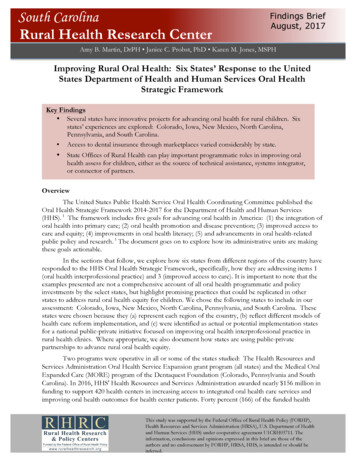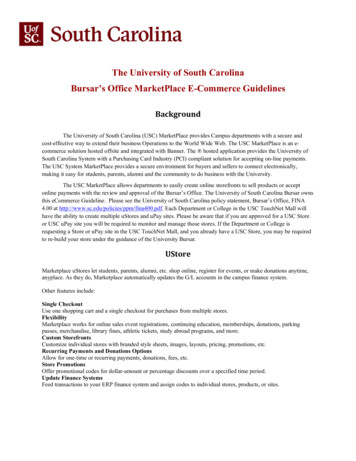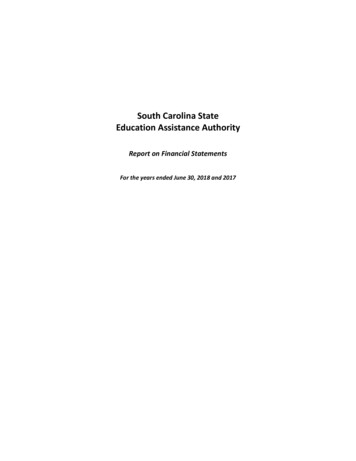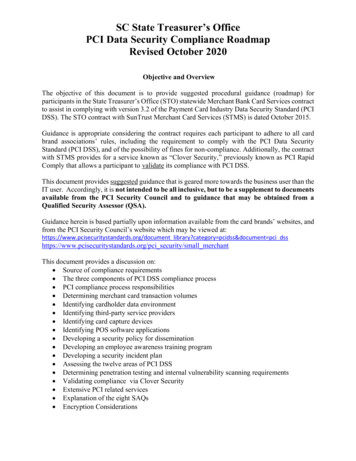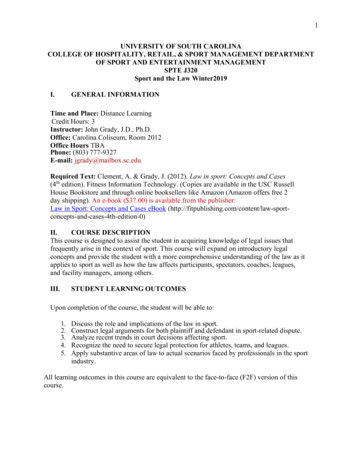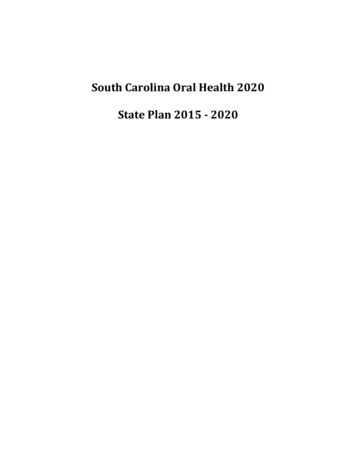
Transcription
South Carolina Oral Health 2020State Plan 2015 - 2020
Table of ContentsExecutive Summaryp. 2Guiding Principlesp. 4Publication Processp. 4Priority 1. Strengthening Public Health Infrastructure.p. 5Priority 2. Improving access to oral health services forvulnerable populations.p. 10Priority 3. Education and Prevention.p. 14Priority 4. Support the integration of public health(population health) priorities, as it relates to oral health,into higher education programs dental education.p. 17Priority 5. Policy and Outreach.p. 19Appendix A: SC Coalition and Advisory Council MemberOrganizationsp. 221
Executive SummaryPriority 1. Strengthening Dental Public Health Infrastructure.South Carolina will establish and maintain the infrastructure within the public health system to encouragethe use of evidence-based public health strategies to address the oral health needs of vulnerable populationsof all ages throughout the state.1.1By 2020, the Division of Oral Health will have a reliable funding stream to supportsufficient staffing levels and contractual partners for full implementation of theirlegislatively authorized and extramurally funded initiatives to meet the goals andobjectives of the SOHP.By 2020, the Division of Oral Health and the SC Oral Health Coalition will establish1.2the SC Oral Health Institute in partnership with the SC Dental Association, SC DentalHygienist Association and the SC Public Health Association.By 2020, a proactive SC Oral Health Coalition will expand with broader membership1.3and empower its members to facilitate improvements in effective oral public healthinfrastructure.By 2020, the Division of Oral Health will be actively involved in the creation of1.4regulatory language that directly affects the promotion and protection of the oralhealth for all the state’s citizenry through community based health services.Priority 2. Improving access to oral health services for vulnerable populations.We will collaborate to assure that all citizens of the state have access to affordable, timely and culturallyand linguistically competent care that is appropriate.2.1By 2020, South Carolina will produce an Oral Health Action Plan for the Centersfor Medicare and Medicaid Services (CMS) that delineates how we will achievethe CMS Oral Health Initiative performance goals.2.2By 2020, South Carolina will develop and disseminate a quality improvementtool kit that facilitates the integration of sustainable culturally and linguisticallycompetent oral health services into other health care services as appropriate toscopes of practice.By 2020, South Carolina will provide evidence-based oral health benefits to children2.3and adults enrolled in Medicaid that facilitate the achievement of the Institute ofHealthcare Improvement’s (IHI) Triple Aim (improved health outcomes, improvedpatient experience, reduced cost of care) for South Carolina.By 2020, South Carolina will incorporate the national quality performance measures2.4identified by the Dental Quality Alliance into the evaluation process for the oralhealth status of the population.Priority 3. Education and Prevention.We will provide the citizens of South Carolina with the most up-to-date information about oraldiseases and conditions across the continuum of life and the evidence-based strategies forprevention and treatment of those conditions. Improve oral health status for populations living withchronic conditions.3.1By 2020, South Carolina will revise and implement a comprehensive socialmarketing campaign for priority populations that emphasizes oral health as anessential component of integrated healthcare and predictor of overall healthstatus.3.2By 2020, South Carolina will organize a library of public health endorsed oral healtheducation and training products and care guidelines for priority populations (e.g.pregnant women, long term care residents) to improve access to reliable andscientifically valid materials.2
3.3By 2020, the SC Oral Health Coalition will ensure dental public health prioritiesinclude chronic disease; specifically ensuring policies and programs in the stateintegrate evidence-based oral health in the state’s most prevalent conditions in child,adult, and senior health.By 2020, South Carolina will have a statewide network of community water3.4fluoridation advocates representing community water systems, primary care,dentistry, early childhood and school health systems integrated into an overall systemfor the prevention of oral diseases and assuring optimal oral health for all.By 2020, South Carolina will have a network of advocates with the necessary3.5knowledge, skills and ability to lead oral health efforts to identify and preventdomestic violence, child and elder abuse through awareness and recognition of thephysical and emotional signs of abuse and the appropriate reporting processes.Priority 4. Improve population health competencies in oral health provider pipeline.We will support the integration of public health (population health) priorities, as it relates to oralhealth, into all health profession education programs.4.1By 2020, DHEC and the James B. Edwards College of Dental Medicine at MUSCwill support the expansion of population health knowledge to all health professionstudents, residents and faculty.By 2020, DHEC and the James B. Edwards College of Dental Medicine at MUSC4.2will collaborate with the Coalition to establish “a network of partners to enhancecommunity access to oral health care and the students’ competence to servevulnerable communities.”By 2020, DHEC and the James B. Edwards College of Dental Medicine will partner4.3with dental hygiene programs to review and recommend joint public healthcurriculum enhancements to ensure future graduates and oral health team membersshare core public health principles and as such are equipped to make public healthcontributions in the future.Priority 5. Policy and Outreach.We will collaborate to identify and advocate for appropriate policies that improve the health of thepopulation.5.15.25.35.4By 2020,the SC Oral Health Advisory Council and Coalition will develop anadvocacy agenda that supports public and private insurance for oral health services inalignment with the goals of the Triple Aim (ref Recommendation 2.3) so that thehealth care system provides optimal oral health for all its citizens especially children,low income adults, persons with special health care needs and chronic or acutediseases, and pregnant women.By 2020, the availability of dental providers in rural SC communities will improvedue to enhanced incentive programs.By 2020 integrated practice and inter-professional behaviors will be evidentthroughout the healthcare system to include, but not limited to, integration of oralhealth concepts into primary health care, chronic disease management, public health,early childhood and school health systems, pharmacy services, long-term care andperinatal health care.By 2020, South Carolina will engage an outside facilitator to update the policy agendato create a model for sustainable dental public health infrastructure thatinstitutionalizes leadership for community based oral health in our state and assuresoptimal oral health for all.3
Guiding PrinciplesThe following guiding principles were used in the creation of the State Oral HealthPlan.1. The State Oral Health Plan should serve as a rallying point for oral healthprofessionals, advocates, and community members, providing a place wherepriorities can be operationalized and coordinated.2. The State Oral Health Plan will follow the action plan template used by theNational Governors Association at their Oral Health Academy in 2000 where:a. We update the vision (what we want for SC in the future)b. Identify priorities/goalsc. Then individual organizations develop tactical plans (feasible strategiesthat are actionable)d. The individual organizations develop work assignments (specific actionsteps to attain the vision)3. The State Oral Health Plan should be a 5 year plan (2015-20209)4. Goals and objectives do not necessarily have to be supported by funding, grants,or legislative mandates.Publication ProcessA draft of the State Oral Health Plan was developed by the Division of OralHealth and its consultants, led by the State Dental Director, Raymond Lala, DDS. Thedraft was submitted on July 31, 2015 to the South Carolina Oral Health AdvisoryCouncil for their review and approval. Once approved, it is shared with theCoalition. Progress reports will be produced on an annual basis and publishedseparately from the original plan. Progress reports will be developed using the sameprocess as was used for publication of the State Oral Health Plan.4
Priority 1. Strengthening Public Health Infrastructure.South Carolina will establish and maintain the infrastructure within the public healthsystem to encourage the use of evidence-based public health strategies to address the oralhealth needs of vulnerable populations of all ages throughout the state.Where We Are in 2014. Between July 1, 2014 and the last update to the State OralHealth Plan in 2006, South Carolina has secured 5,220,000 in extramural fundingfor activities related to public oral health with some support lasting into 2018.GrantFundingAmountTimePeriodAwardeeCenters for Disease Control & Prevention (CDC)State Infrastructure 1.5 million2013-18DHECHealth Resources & Services Administration OralHealth Workforce 1.5 million2012-15USCDentaQuest Foundation Implementation for OralHealth 2014 300,0002012-14USCDentaQuest Foundation Planning for Oral Health2014 100,0002011-12USCCDC State Infrastructure 1.75 million2008-2013DHECHead Start Dental Home 10,0002009-10DHECAmerican Dental Association School Nurse Study 50,0002009USCAssociation of State & Territorial Dental Directors(ASTDD) – Head Start Study 2,5002007DHECASTDD – CSHCN Study 7,5002006 & 2008DHECFull-Time Equivalents. While the Division of Oral Health (DOH) at DHEC hassuccessfully re-competed for CDC infrastructure funding, this remains its solesource of support for public health infrastructure. Should CDC funding be furtherreduced, the future of the DOH in its current form would be uncertain. The DOHemployees the following (on the next page) 4.0 full-time equivalent (FTE) positions,three of which are funded by the CDC Infrastructure Grant entirely:5
Ray Lala, DDS, Dental Director, is supported entirely by the Maternal andChild Health Block GrantGerta Ayers, MPH, fulfills three programmatic roles as Coordinator for theCDC Grant, School-based Oral Health Prevention Programs, and the WaterFluoridation ProgramWes Gravelle, MPH is an epidemiologist responsible for the DOH’smanagement of surveillance and water fluoridation dataAn Administrative Specialist position remains vacant, however the Maternaland Child Health Bureau is contributing 0.3 FTE of an existing person as asearch for the full-time person is planned.External Contractors. The DOH enjoys contractual relationships for theimplementation of its CDC Infrastructure Grant, as well as in carrying out many ofits legislatively authorized activities. A summary of the partners and scopes of thecontracts are summarized in the table below:Contracting PartnerSC Dental AssociationCollege of DentalMedicine, MedicalUniversity of SouthCarolina, Division ofPopulation HealthRevenue & FinanceAffairs Office (formerlyOffice of Research &Statistics)Scope of ServiceEducational ConsultationServicesEvaluation, Research, &Grants DevelopmentContact PersonMary Kenyon JonesData ServicesVaries, depending ondatasetAmy Brock MartinCoalition & Advisory Council. The Division of Oral Health enjoys the engagedsupport of a statewide coalition that provides considerable input and feedback onthe public oral health needs of South Carolina. The Coalition represents manyorganizations from a variety of organizations. The list of participating coalitionmember organizations is including in Appendix A. The Advisory Council providesdedicated leadership to the DOH by providing it with advice on how to navigatepolicies to further public oral health in the state. The Advisory Council members arealso identified in Appendix A.6
Where We Want to be in 2020. Public oral health infrastructure is defined byPeople, Programs, Policies, Partnerships, or P4. The following P4 recommendationsprovide guidance through 2020.P4 for Priority 1. Strengthening Public Health Infrastructure.PeopleDivision of OralHealth staff andother public healthofficialsProgramsExtramurallyfunded esPartnershipsCoalition &Advisory CouncilRecommendation 1.1By 2020, the Division of Oral Health will have a reliablefunding stream to support sufficient staffing levels and contractual partners for fullimplementation of their legislatively authorized and extramurally funded initiatives tomeet the goals and objectives of the SOHP.The Division of Oral Health (DOH) is administratively organized in theMaternal Child Health Bureau of the SC Department of Health and EnvironmentalControl (DHEC). Historically, the agency’s leadership has given demonstrablesupport to the DOH evidenced by active participation on the Advisory Council. Weanticipate the agency leadership continuing to work closely with the Coalition andAdvisory Council to assess the staffing needs of DOH as its scope of programs andservices grow.Included in this assessment should be the implementation of Act 235,passed by the SC General Assembly in 2010. Section 1 of the legislation calls onDHEC to establish Community Oral Health Coordinator positions for patient andparent education, oral health surveillance, community oral health education andsystem development, patient navigation through the oral health system of care.Beyond public health infrastructure, the purpose of Act 235 is to ensureunderserved children at-risk for poor oral health are identified early and their carecoordinated in ways that guarantees ongoing, routine preventive care. Act 235 wasa significant policy achievement, but no state funding was appropriated for itsimplementation.Recommendation 1.2By 2020, the Division of Oral Health and the SC OralHealth Coalition will establish the SC Oral Health Institute in partnership with theSC Dental Association, SC Dental Hygienist Association and the SC Public HealthAssociation.As public health agencies and their governmental support retract in size,establishing an independent, non-profit organization in South Carolina that canprovide sustainable momentum for public oral health programs, policies, andservices is essential. Incubated through the new Oral Health Section of the SCPHA7
using non-profit business development principles, the Oral Health Institute’s (OHI)mission would likely be carried out through four divisions, each with a specific set ofservices and products:1. Center for Quality Improvement2. Center for Community Oral Health Outreach and OH Status Surveillance3. Innovation Center for Systems Development4. Education and Training CenterRecommendation 1.3By 2020, a proactive SC Oral Health Coalition willexpand with broader membership and empower its members to facilitateimprovements in effective dental public health infrastructure.South Carolina has made tremendous gains in access to dental treatment forits underserved children through a strong statewide coalition. The juxtaposition ofthese improvements has been a retraction by attrition of essential public healthinfrastructure necessary to systematically prevent the full spectrum of oral diseasesthroughout the lifespan. While the Coalition and Advisory Council, in their currentforms, have achieved many of the goals and objectives, it has become clear thattransitioning from the current ‘multi-hub’ configuration of interconnectedness to a‘core periphery’1 is essential for re-establishing an effective public oral healthinfrastructure for the future.As such, the statewide oral health coalition, with leadership from the DOHwill establish an oral health section of the South Carolina Public Health Association(SCPHA), which is a chapter of the American Public Health Association (APHA). TheAdvisory Council will continue to function in its current form. The coalition,however, may re-organize itself as members of a new oral health section within theSCPHA where oral health systems improvement and advocacy initiatives can bedeveloped. This new structure would formalize the coalition in a way that would bemore sustainable than its current configuration. As part of a functioning unit ofSCPHA, it would finally be able to compete as a non-profit organization, separatefrom government and academia. It would also benefit from growing its membershipto include other existing SCPHA members currently not involved in oral health butwhose work is germane to effective policy that leads to improvements in publichealth systems. Practically speaking, the coalition would be in a position tocollaborate on activities with other sections of the SCPHA, such as (a) alcohol,tobacco, and other drugs; (b) environmental health, and (c) nutrition. We believethis new dynamic will strengthen ‘systems thinking’ among the coalition whocurrently operates in isolation from other organized forms of public healthadvocacy.The Division of Oral Health, led by Dr. Ray Lala will serve as the inauguralSection Chair, thus providing leadership to the coalition’s transition. The State OralKrebs V and Holley J. (2002). Building Smart Communities through NetworkWeaving. Retrieved from http://www.orgnet.com/BuildingNetworks.pdf onSeptember 1, 2014.18
Health Plan will be used to frame the new oral health section. Its first set ofobjectives is to leverage the lessons learned and products developed since 2000 toaddress Community Oral Health Coordination and how it should be institutionalizedto facilitate early childhood systems transformation.Recommendation 1.4By 2020, the Division of Oral Health will be actively involved in the creation ofregulatory language that directly affects the promotion and protection of the oralhealth for all the state’s citizenry through community based health services.As the Coalition and other oral health key stakeholders work to improve oralhealth for South Carolina, the Division of Oral Health will engage with them to provideclarity on legislation, provisos, and other regulatory mechanisms. One area where theDivision of Oral Health has begun developing regulatory language is in Community OralHealth Coordination. In 2010, the South Carolina General Assembly passed Act 235,legislation that called on the South Carolina Department of Health and EnvironmentalControl’s Division of Oral Health (DHEC), to make enhancements to the state’s oralhealth infrastructure, relying in part, on a new network of local oral health coordinators.Beyond public health infrastructure, the purpose of Act 235 was to ensure underservedchildren at-risk for poor oral health are identified early and their care coordinated in waysthat guarantees ongoing, routine preventive care. It was the result of a concerted effortby our state’s oral health coalition, referenced in the 2006 State Oral Health Plan.9
Priority 2. Improving access to oral health services for vulnerable populations.We will collaborate to assure that all citizens of the state have access to affordable, timelyand culturally and linguistically competent care that is appropriate.Where We Are in 2014. South Carolina has seen improvements in oral healthservices since our last update to the State Oral Health Plan. Data demonstrate thepower of the collective impactgenerated by the state’s keystakeholders. The most recentSouth Carolina Oral Health NeedsAssessment for children not onlydemonstrated improvements inkey utilization indicators, it alsorevealed the elimination of race,ethnicity, and certain incomedisparities for untreated cariesand treatment urgencies.Unfortunately, disparitiescontinue for caries experienceswith exacerbated inequities forrural children.In addition to children, work remains in improving access to care for adults,especially among our vulnerable citizens including persons who have chronicdisease, are pregnant, low income, uninsured, minority, rural, and seniors.Where We Want to be in 2020. Improving access is a complicated process ofaddressing individual, systems, and environmental factors including but not limitedto cultural norms and beliefs, geography, and finance. As such, we make thefollowing recommendations for addressing inequities in oral health for SouthCarolina.P4 for Priority 2. Improving access to oral health services for vulnerable populations.People Safety netproviders SystemsfacilitatorsPrograms Patient navigation Safety Net programs Integration modelsPolicies Reimbursement Loan Repayment ShortagedesignationsPartnerships Medicaid Safety netassociations10
Recommendation 2.1By 2020, South Carolina will produce an Oral HealthAction Plan for the Centers for Medicare and Medicaid Services (CMS) thatdelineates how we will achieve the CMS Oral Health Initiative performance goals.The CMS Oral Health Initiative established two performance goals, to beaccomplished over five years by FFY 2015:Goal #1 – Increase by 10 percentage points the proportion of Medicaid andCHIP children ages 1 to 20 (enrolled for at least 90 days) who receive a preventivedental service.Goal #2 – Increase by 10 percentage points the proportion of Medicaid andCHIP children ages 6 to 9 (enrolled for at least 90 days) who receive a sealant on apermanent molar tooth.In a recent CMS communication, they encouraged every state to develop anOral Health Action Plan to articulate specific steps they plan to take to achieveimprovement. As of September 1, 2014, CMS had received Action Plans from the 22states, however South Carolina was not one of these states. Southern states tosubmit an Oral Health Action Plan include Alabama, Tennessee, and Virginia.Recommendation 2.2By 2020, South Carolina will develop and disseminate aquality improvement tool kit that facilitates the integration of sustainable oral healthservices into other health and social services as appropriate to scopes of practice.Approximately 10 years ago, South Carolina benefited from a successful pilotpatient navigation program focused on community oral health with funding fromthe Robert Wood Johnson Foundation. Those lessons learned informed futureextramurally funded activities such as the oral health component of the Maternal,Infant and Early Childhood Home Visitation Program and the Quality andTechnology Improvement Program (QTIP). Through these experiences, barriers toproviding fluoride varnish, including reimbursement and patient flow, have beendelineated. As such, publishing quality improvement strategies, as well as policiesthat support provider behavior change, is essential.In addition to pediatric settings, supporting medical providers who provideongoing care to people with chronic disease is a priority. This priority aligns withthe draft strategic plan of DHEC’s Bureau of Chronic Disease and Prevention, whichstates (Goal 4) “South Carolinians at risk or living with chronic diseases receive theright care in the right place at the right time. In addition to making referrals todentists for ongoing care, medical providers can conduct oral screenings andrecommend daily hygiene behaviors that will control the oral infections for theirpatients, which will result in better control of certain chronic diseases such asdiabetes.11
Recommendation 2.3By 2020, South Carolina will provide evidence-based oralhealth benefits to children and adults enrolled in Medicaid that facilitate the achievementof the Institute of Healthcare Improvement’s (IHI) Triple Aim (improved healthoutcomes, improved patient experience, reduced cost of care) for South Carolina.While improving access to care is an important public health priority,improved utilization should also reflect improved quality of care and populationoral health status enhancements in cost effective ways. The Triple Aim2 is thepervading framework for population health improvement that balances theindividual patient care experiences with sustainable health system performance.Reimbursement strategies for both medical and dental providers shouldfacilitate moving patient care for treatment to maintenance and prevention. Oneexample is the integration of oral care into the chronic disease management modelfor people with diabetes. Current research from MUSC has demonstrated annualbasic periodontal therapies result in improved in diabetes management indicatorssuch as hemoglobin-a-1-c levels.3As previously discussed in patient navigation is an essential component ofsuccessfully facilitating access and should therefore be reflected in evidence-baseddental benefits. An attribute of the Triple Aim infrequently described is Berwick’scall for an integrator; an organization that assumes the responsibility for assuringthe three outcomes of population health, quality, and cost improvements areachieved. At the local systems level, one could argue the Community Oral HealthCoordinator is best positioned for this role for dental health. On a broaderstatewide systems-level, perhaps the proposed Oral Health Institute could fulfill thisrole.Recommendation 2.4By 2020, South Carolina will incorporate the nationalquality performance measures identified by the Dental Quality Alliance into theevaluation process for the oral health status of the population.The Dental Quality Alliance’s mission “is to advance performancemeasurement as a means to improve oral health, patient care, and safety through aconsensus-building process.4” The objectives of DQA are:Berwick DM, Nolan TW, & Whittington J. Triple Aim: Care, Health, and Cost.Health Affairs, 27(3), 759-769.3 Sora ND, Marlow NM, Bandyopadhyay D, Leite R, Slate E, Fernandes J. Metabolicsyndrome and periodontitis in Gullah African Americans with type 2 diabetesmellitus. J Clin Periodontal. 2013 Jun;40(6):599-606.4 The Dental Quality Alliance. Quality Measurement in Dentistry: A Guidebook.Retrieved from212
1. “To identify and develop evidence-based oral health care performance measuresand measurement resources.”2. To advance the effectiveness and scientific basis of clinical performancemeasurement and improvement.”3. “To foster and support professional accountability, transparency, and value inoral health care through the development, implementation, and evaluation ofperformance measurement.”DQA’s work is carried out through its Executive Committee and four advisorygroups with the Implementation, Maintenance, and Outcomes AssessmentCommittee leading the identification of performance measures for dentistry. Asthere is work is completed, South Carolina will examine their relevance for ourpopulace.http://www.ada.org/ /media/ADA/Science%20and%20Research/Files/DQA Guidebook 52913.ashx on October 19, 2014.13
Priority 3. Education and Prevention.We will provide the citizens of South Carolina with the most up-to-date informationabout oral diseases and conditions across the continuum of life and the evidence-basedstrategies for prevention and treatment of those conditions. Improve oral health status forpopulations living with chronic health challenges.Where We Are in 2014. Many successful educational products have beendeveloped by the Division of Oral Health facilitated by the Educational Specialist,Mary Kenyon Jones, through a partnership with the South Carolina DentalAssociation. Some notable resources include: the Head Start Toolkit, certified oralhealth trainings for childcare providers, a Community Water Fluoridation Advocacycurriculum, Oral Health During Pregnancy Standards of Care and Community OralHealth Coordination Competencies for Maternal, Infant, and Early Childhood HomeVisitors. What is needed now is a systematic mechanism for efficient dissemination,as well as curricula that addresses a broader range of oral diseases that affect agegroups beyond childhood and includes special populations and chronic conditions.Where We Want to be in 2020. Improving the knowledge and practice of oralhealth prevention across the life continuum is not a novel priority. One of the mostsuccessful educational campaigns is Smiles for Life;5 a multi-module curriculum thataddresses oral health needs for every age. South Carolina will be more deliberate incoordinating and meeting the oral health educational needs of all South Carolinians.Recommendation 3.1By 2020, South Carolina will revise and implement acomprehensive social marketing campaign (for priority populations) that emphasizes oralhealth as an essential component of integrated healthcare and a predictor of overallhealth status.In 2004, the Division of Oral Health contracted with Hyde Park to develop asustainable five-year social marketing plan that was partially implemented. Thepower of public health service announcements and social marketing campaigns hasbeen well documented. It is increasingly important for oral health key stakeholdersto engage in these activities so that oral health garners the same level of importanceas other public health priorities such as smoking prevention and breastfeeding.Society of Teachers of Family Medicine. Smiles for Life: A National Oral HealthCurriculum. Retrieved ntent.aspx?tut 555&pagekey 62948&cbreceipt 0 on September 9, 2014.514
Recommendation 3.2By 2020, South Carolina will organize a library of publichealth endorsed oral health education and training products and care guidelines forpriority populations (e.g. pregnant women, long term care residents) to improve access toreliable and scientifically valid materials.As previously stated, centralized availability of public oral health materials has beenlacking in our state. As the new oral health section of the SCPHA and the Oral HealthInstitute concepts evolve, it will be essential to design a central place whereproviders and consumers can access materials and pr
South Carolina will establish and maintain the infrastructure within the public health . DentaQuest Foundation Implementation for Oral Health 2014 300,000 2012-14 USC DentaQuest Foundation Planning for Oral Health 2014 100,000 2011-12

